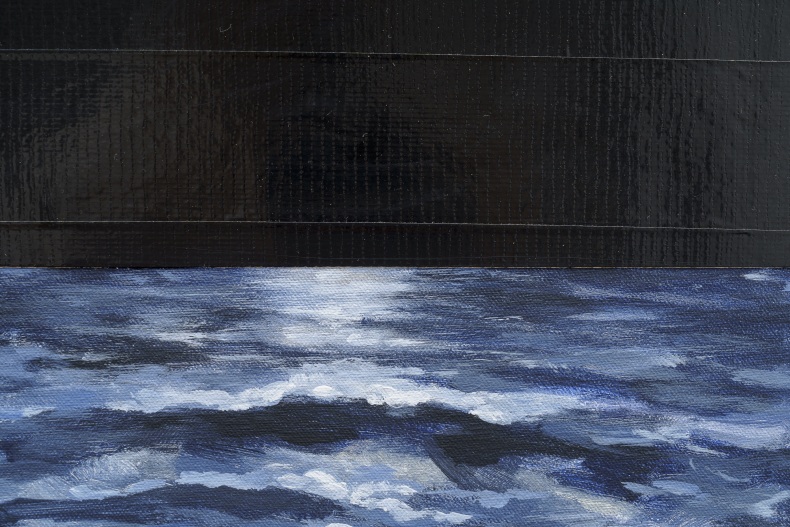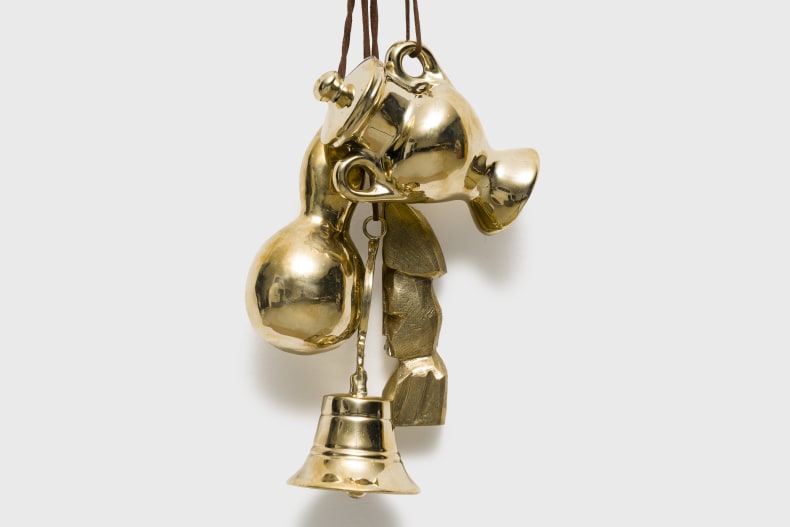Nara Roesler is pleased to present Eu estou aqui com toda minha gente [I Am Here with All My People], Jaime Lauriano’s first solo exhibition at the gallery’s Rio de Janeiro outpost. Featuring 12 works, most of which are previously unseen, the exhibition includes a critical essay by Ademar Britto. The exhibition title is taken from the song A Força da Jurema (The Power of Jurema), recorded in 1973 by the group Os Tincoãs. The song evokes ideas of healing and the orixás, and pays homage to Oxum. During the exhibition, in late November, the gallery’s publishing house will launch the publication Jaime Lauriano – Mapeamentos, the first monograph dedicated to the artist, published by Nara Roesler Books, including essays by Tadeu Chiarelli, Keyna Eleison, and Sylvia Monasterios.
One of the new works included in the exhibition features four objects from the Pencas series, comprising brass sculptures suspended from leather straps with brass rings. The new sculptures take the forms of jatobá seeds, cowrie shells, an ogó of Exu, bells, agogôs (double bells), quartinhas (small ritual jars), alguidar bowls (ceramic offering dishes), mugs, pemba chalks (sacred chalk used for inscriptions), pipes, and gourds–elements from the ritual practices of Candomblé and Umbanda–thus creating a kind of offering to Afro-Brazilian culture and its enduring resistance throughout Brazil’s history. In this body of work, Jaime Lauriano evokes the creole jewelry of the 18th and 19th centuries, considered part of Bahia’s heritage and Afro-Brazilian culture, as symbols of Black resistance under the slave regime–among the oldest Afro-descendant artistic expressions in the country.
Maps, a recurring interest in Lauriano’s practice, are present in the work A new and accurate map of the world: democracia racial, êxodo, genocídio e invasão (2025), comprised of two drawings in white pemba and dermatographic pencil on black cotton, each measuring 150 × 170 cm. This series recreates, based on historical maps and nautical charts, one of the most emblematic scenes of modern history: the navigations and the “discovery” of the New World. However, unlike original maps that often featured vivid colors to celebrate newly explored territories, Lauriano adopts a visual reduction–white on black–reinterpreting the first representation efforts tied to the exploitation of timber and indigenous labor, the earliest labor force in what would later become the nation-state. The artist counters the idyllic imagery of ancient maps by inscribing terms such as “invasion,” “ethnocide,” “racial democracy,” and “cultural appropriation”–extracted from books that shaped Brazilian historiography.
The painting Entradas em Minas Gerais (2025) is part of Lauriano’s research, initiated in 2022 on the critical revision of historical paintings that helped shape Brazil’s official memory. In revisiting academic images produced between the late 19th and early 20th centuries, the artist sensed that colonization was often “consistently presented in idealized form, transformed into a heroic, civilizing gesture,” while “the presences, resistances, and experiences of Afro-Indigenous violence were systematically silenced.”
Lauriano states: “My interest lies in questioning that operation, dismantling its celebratory logic, and transforming historical painting into a counter-monument: no longer a place of consecration but a field of dispute, friction, and reflection.” He “empties” the painting of its figures, leaving only the landscape. On this depopulated surface, he applies a profusion of stickers that evoke both colonial violence and Afro-Indigenous resistance. On the frame itself, he installs miniature figures reenacting battles between colonial soldiers and entities from Afro-Brazilian religiosity, such as Zé Pilintra. “Thus, the past does not return as a pacified myth, but as a symbolic field of conflict in which painting becomes a contested territory.”
Another new series, created especially for the exhibition, titled o sobrado de mamãe é debaixo d’água (Mommy’s House Is Under Water), the series originated from a photograph the artist took at Copacabana Beach. Here, Lauriano returns to the landscape genre, but with a novel approach, distancing himself from the conflict-driven imagery present in his earlier work. “The focus now is the exploration of visual tensions between fields of color, created through a variety of materials. The sea of Rio de Janeiro is not only a backdrop but a conceptual point of departure. My decision to immerse myself in its waters relates to this series’ debut in my solo show in the city, but above all to my fascination with the complex history carried by transatlantic waters. They bear witness to a past of colonial violence and suffering, yet they are also the routes that brought the rich African legacies that have profoundly shaped Brazilian culture and identity over time,” he explains. Lauriano affirms: “The series O sobrado de mamãe é debaixo d’água positions itself, therefore, as a poetic celebration of the resilience and richness of Afro-Brazilian culture and its ability to flourish and resist, transforming pain into history and struggle.”



















